


|
|
|
|||||||||||||||
|
|
||||||||||||||||
|
|
|||
|
|
Denmark Frederiksborg Castle
Acquired by King Frederick II (r. 1559-1588) of Denmark and Norway in 1560 as the Kings Hunting Lodge, Frederick began the work of converting it into a royal palace. From 1599 to 1615 his son King Christian IV (1577-1648) developed it into the largest Renaissance Castle in Scandinavia and one of the most magnificent in the world. Located in Hillerød, 18.6 miles (30 km) north of Copenhagen, Frederiksborg Castle is beautifully situated on three small islets. Designed in the French and Dutch Renaissance style and constructed of red bricks with sandstone details and sweeping gables: its imaginative spires decorate the 4-storey high building consisting of three wings, all of which are brilliantly decorated and lavishly furnished. The towers, moat, fountains, and courtyards, lake and gardens give the castle a fairy-tale appearance. 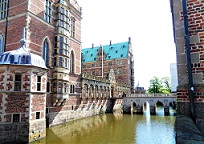 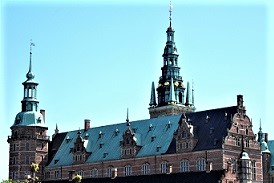 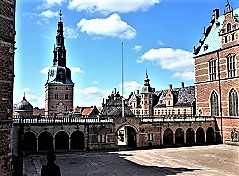 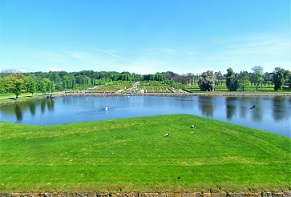 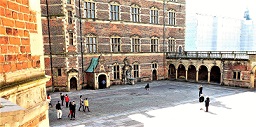 The main courtyard contains the Fountain of Neptune designed by Adrian de Vries (1623), although this is a copy, as the original was taken to Sweden when the castle was occupied by the Swedes in 1659. 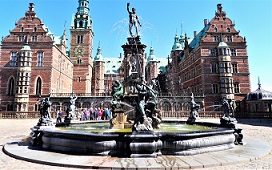 Throughout the seventeenth century Frederiksborg Castle was often used as a royal residence, but from the 18th century onwards its popularity with the Royal Family faded and it was seldom used by them. In 1859 the castle was ravaged by a fire which caused major damage to the fabric and contents. The renovation work was carried out, with much of the finance coming from the Carlsberg Foundation who reproduced many of the items which can be seen in the castle today, although they also brought in replacement items from the appropriate era and style. The Knights or Great Hall was severely damaged by the fire in 1859 and underwent reconstruction in 1860-1864. It is decorated with portraits of the Kings and Queens of the Glücksborg Line. In the hall is the trumpeters’ balcony from where the entering royalty was saluted. The tapestries of Karel von Mander commissioned by King Christian IV which were hung in this hall were destroyed by the fire. 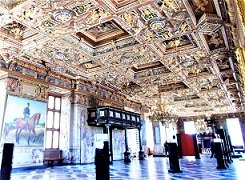 The Knights Chamber with its long-corbelled ceiling was used as a dining room by the Lords and Ladies of the court during the time of Christian IV. This also was ravaged by fire and subsequently restored. The castle chapel managed to escape damage in the fire. The nave and its Gothic stellar vaulting held up with gilded sandstone columns are part of the original construction of Christian IV. The magnificent interior with its gallery is richly decorated with paintings, marble inlay and alabaster figures, pews with marquetry inlay, a silver font, an ebony pulpit, and an organ which is still used to give concerts. The chapel has great ceremonial importance - Danish kings having been crowned and anointed here. The first being King Christian V in 1671. It was he who established the Chapel of Orders in 1693 and to have his shield displayed on the wall. 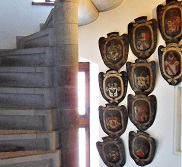 Since then, the shields portraying the coats of arms of the Knights and Ladies who have received the Order of the Elephant and the order of Dannebrog have been hung on the walls of the chapel and the stairway of the tower. Today there are over 3,500 shields on display. At the side of the Chapel is the King's Oratory which is the King's personal chapel. 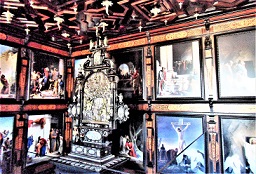 This was commissioned at the same time as the chapel in 1617 and contains 24 paintings on copper. These were reproduced following the fire in 1859. The silver altar was re-erected in 1938. Many of the rooms of the castles can be visited including some of the beautiful bedrooms. 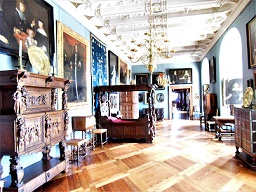 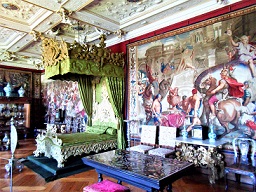 Another room worth seeing is the Rose Room which was the dining room for the ladies and gentlemen of the court. The castle's interior shows the changing styles and periods during its history and contains a fine collection of paintings, busts, drawings and photographs. It also contains a fine selection of beautiful and ornate ceilings, many of which are decorated with mythological and Danish folklore scenes, royal and holy figures, and historical events. A virtual tour of the castle can be taken and many of its rooms and contents can be seen by clicking on the link below. Since 1882 Frederiksborg Castle has been used as Denmark’s Museum of National History and contains items tracing the history of Denmark from 1500 to the present day. It also houses the National Portrait Gallery, containing one of the largest and most important collections of portraits in Denmark. To see more photographs and take a virtual tour of the site click on the photoshow below.
|
|
|
|
|
|||
All Photographs were taken by and are copyright of Ron Gatepain
| Site Map |
